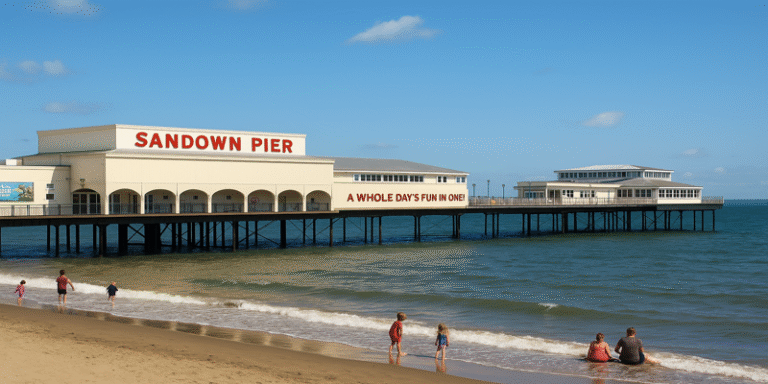Nestled on the eastern coast of the Isle of Wight, Sandown Pier is more than just a wooden platform stretching out into the English Channel. It’s a symbol of British seaside heritage, an evolving site of recreation, and a vital part of the local tourism economy. From its Victorian origins to its current incarnation as a multifaceted entertainment hub, Sandown Pier invites both locals and visitors to experience nostalgia, amusement, and community connection all in one place. This article offers a comprehensive view of Sandown Pier’s history, cultural value, and contemporary appeal.
1.0 The Origins of Sandown Pier: Victorian Leisure Culture
Built in 1879, Sandown Pier was originally designed during a time when the British seaside was becoming increasingly popular as a recreational destination. This period saw a cultural shift—from industrial labour to the celebration of leisure, health, and coastal beauty (Gray, 2020). The rise of rail transport made the Isle of Wight more accessible to the middle class, thereby boosting seaside tourism (Doe, 2003).
Victorian piers were more than mere platforms; they were stages for spectacle, providing venues for musical performances, strolling, and public display (Ferry, 2025). Sandown was no exception, equipped with tea rooms, theatres, and spaces for brass band concerts. These were reflective of the era’s notion of respectable fun and social visibility.
2.0 Piers and Post-war Decline: Shifting Sands
Like many British piers, Sandown Pier saw a decline post-World War II. The growth of international travel, especially package holidays to Spain and France, drew crowds away from traditional British coastal resorts (Beatty et al., 2010). In this period, the pier’s infrastructure suffered, and maintenance costs soared.
According to Chapman et al. (2020), piers across the UK were facing an “identity crisis,” with many viewed as financial liabilities rather than cultural assets. Nevertheless, Sandown Pier retained its charm for local residents, even as it required substantial reinvestment to compete with modern tourist attractions.
3.0 The Revival: Heritage Meets Innovation
The early 21st century brought a revival in interest towards heritage tourism. Piers were rebranded as nostalgic sites, offering a connection to the past while incorporating new amenities such as laser tag, indoor arcades, and family attractions (Chapman & Blake, 2020).
Sandown Pier, in particular, embraced this dual identity. It preserved its architectural legacy—such as the pavilion theatre and original Victorian balustrades—while integrating contemporary amusements. The “Pier Review” sustainability toolkit notes how piers like Sandown have transformed into vital multifunctional public spaces that serve educational, recreational, and ecological purposes (Chapman et al., 2020).
4.0 A Whole Day’s Fun: What Visitors Experience Today
A visit to Sandown Pier today offers something for everyone. For younger visitors, there’s mini-golf, soft play zones, and amusement arcades. Adults can enjoy the tranquil sea views, cafes, and the heritage interpretation boards that line the pier walkway, explaining its historical and environmental significance (Owen et al., 2023).
The pier plays host to seasonal events—firework displays in summer, Christmas fairs, and heritage walks—that help sustain year-round tourism. The Isle of Wight Council has collaborated with academics and local businesses to keep Sandown relevant and accessible (Marsh et al., 2023).
5.0 Social and Economic Importance
Beyond leisure, Sandown Pier is an essential contributor to the local economy. A study by Beatty et al. (2010) estimated that up to 40% of Sandown’s tourism revenue stems from pier-related activities. It also serves as an employment hub, especially for seasonal workers, and contributes indirectly through hospitality, retail, and transport sectors.
Its social value is equally important. The pier provides intergenerational space—where grandparents can reminisce, parents can relax, and children can play. It is a place of shared memory, reinforcing local identity while welcoming tourists (Gill et al., 2022).
6.0 Environmental and Coastal Considerations
Sitting at the edge of the dynamic Solent coastal system, Sandown Pier also faces the challenges of erosion, rising sea levels, and storm damage. A comprehensive environmental risk study by McIness (2004) highlights Sandown as a zone of moderate to high vulnerability.
As such, coastal management has become an essential aspect of the pier’s preservation strategy. Local authorities, supported by academic institutions, have employed marine spatial planning and engineering assessments to safeguard the structure while balancing ecological needs (Loader, 2011).
7.0 Sandown’s Place in the National Consciousness
Sandown Pier isn’t just a local feature—it’s part of the broader tapestry of British seaside culture. In literature, photography, and memory, piers like Sandown evoke a particular Britishness—one of stripy deckchairs, sticks of rock, and bracing sea air (Walton, 2000).
The Twentieth Century Seaside Architecture report recognises Sandown’s pier as an exemplar of seaside modernity, blending tradition with transformation (Ferry, 2025). Its story reflects a national narrative of decline, rediscovery, and revitalisation.
A Timeless Treasure
Sandown Pier has weathered time, tides, and transformation. What began as a Victorian marvel is now a vibrant centre of leisure, community, and history. As the Isle of Wight continues to position itself as a sustainable and heritage-driven destination, Sandown Pier stands tall—a testament to resilience and recreation.
Whether you’re dropping a coin into a vintage arcade machine, walking hand in hand along the breezy boardwalk, or watching the waves crash beneath your feet, Sandown Pier truly offers “a whole day’s fun in one.”
References
Beatty, C., Fothergill, S., Gore, A., & Wilson, I. (2010). The seaside tourist industry in England and Wales. Sheffield Hallam University.
Chapman, A., Richards, S., & Blake, A. (2020). Pier Review: Sustainability Toolkit for British Seaside Piers. Bournemouth University.
Doe, A.R. (2003). The Railways of the Eastern Isle of Wight: 1845–1901. University of Southampton.
Ferry, K. (2025). Twentieth Century Seaside Architecture: Pools, Piers and Pleasure Around Britain’s Coast. RIBA Publishing.
Gill, D.W.J. et al. (2022). From the Wash to the White Cliffs: Heritage and the Economy. University of Kent. Gray, F. (2020). The Architecture of British Seaside Piers. Routledge.
Loader, R.D. (2011). Quantifying Coastal Heritage Change: Isle of Wight Case Study. ProQuest.
Marsh, N., Owen, J., & Jones, S. (2023). Visions of Sandown: Partner Report for Isle of Wight Council. University of Southampton.
McIness, R.G. (2004). EUROSION: Isle of Wight Coastal Management Report. EUCC.









